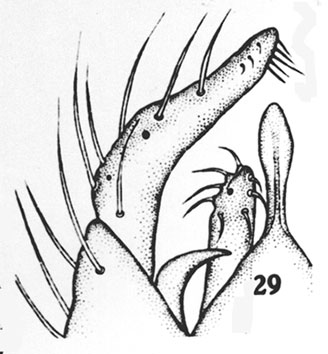|
Chironomus apicatus Johannsen 1932 Adult Male and female. Differs from the typical form [i.e. C. costatus] in having the fore basitarsus 1.85 times tibia in length, the tarsi largely brown, only the two apical segments somewhat paler brown. The mesonotal vittae are brownish. Crossvein of wings brown. Hypopygium as figured [below]. Length 5 mm. Bred from larvae found in pools.  Illustration of the hypopygium of C. apicatus From Johannsen (1932) Additional data on anterior tarsi of type (thanks to Duncan Sivell, Natural History Museum): Ta1 twice the length of Ta2; Ta2-4 subequal but decreasing in length; Ta5 less than half the length of Ta4. Fourth instar larva: described by Lenz (1937) as "Plumosus-type".
Breeding in pools. In Indonesia found in salt ponds and a pool at 29°C and pH2.83 (Lenz 1937). Found: Type locality - Toba Dist., Samosir, Sumatra, INDONESIA, also Sigaol, Samosir. |
Modified: 5 April 2022
Access: Unrestricted
Copyright © 2010-2022, Jon Martin.